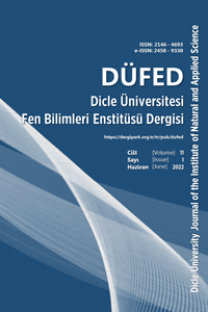Karbon Fiber Takviyeli Kompositlerin Düşük Sıcaklıklarda Düşük Hızdaki Darbe Dayanımı
Karbon fiber takviyeli kompozitler (KFTK); 22,5°C (strain–gage li), 22,5°C, 0°C, -30°C ve-60°C sıcaklıklarda düşük enerjili darbe testlerine tabi tutulmuşlardır. CFU10T karbon fiber ve CR80 reçine matriks malzeme olarak kullanılmıştır. Numuneler 100 X 100 mm. genişlik/uzunluk ve 2 mm. kalınlıkta 8 tabakalı olarak hazırlanmış ve quasi-isotropic olarak ayrı ayrı yönlendirilmişlerdir. Tabakalar el yapımı yayma metodu ile hazırlandıktan sonra ASTM D7136’ya göre düşük hızda darbe testine tabii tutulmuşlardır. Kritik kuvvet-zaman, gerinim-zaman grafikleri hazırlanarak ayrı ayrı hasar analizleri yapılmıştır. Sıcaklık azaldıkça temas kuvvetinin arttığı ve temas zamanının azaldığı gözlemlenmiştir.
Low Velocity Impact Damage Response of Carbon Fiber Reinforced Composites at Low Temperatures
Carbon Fiber Reinforced Composite (CFRC) plates have been subjected to low energy impact tests at 22,5°C (with strain gauge mounted), 22,5°C, 0°C, -30°C and -60°C separately. CFU10T carbon is chosen as fiber material and CR80 epoxy resin as matrix. The samples have been prepared as 100 X 100 mm. width/length and 2 mm. (thickness), 8 layered respectively and have been orientated as quasi-isotropic. The plate samples have been prepared by hand layup method. Low velocity impact tests have been carried out by Weight Drop Impact Test Setup according to ASTM D7136. Critical response force-time, strain and damage response have been investigated. It has been observed that; as the temperature decreases, contact forces increase and contact time decreases. The laminate number and lay up orientation also affect the low impact energy behavior of plates. As the temperature decreases, impact strength of CFRP plates decreases. It has been experimentally observed and proved that low temperature decreases impact strength.
___
- REFERENCES:[1] Reinhart TJ, Clements LL. (1987). "Introduction to Composites, Engineered Materials Handbook" Volume 1: Composites. In: Dostal CyrilA et al., editors. ASM International; p27.
- [2] Agarwall, B. D. and Broutman, L. J. (1980), Analysis and Performance of Fiber Composites.
- [3] Stuart W.J, (2010), "Composite Materials Lay Up Lab Lecture Notes" Edmonds Community College.
- [4] Belingardi, G., Vadori, R., (2002), "Low velocity impact tests of laminate glass-fiber-epoxy matrix composite material plates", Internal Journal of Impact Engineering, Vol.27; pp. 213-229. [5] Mirevski, T., Marshall, I.H., Thomson, R., (2006), "The influence of impacter shape on the damage to composite laminates", Journal of Composite Structures, Vol. 76; pp.116-122 .[6] Aslan Z., Karakuzu R., Okutan B., (2003), ”The response of laminated composite plates under low-velocity impact loading", Journal of Composite Structures, Vol.59; pp.119-127.
- [7] Milli, F., Necib, B., (2001), "Impact behavior of cross-ply laminated composite plates under low velocities", Journal of Composite Structures, Vol.51; pp.237-¬244.
- [8] Hoşur, M.V., Karim, M.R., Jeelani, S., 2003), "Experimental investigations on the response of stitched/unstitched woven S2-glass/SC15 epoxy composites under single and repeated low-velocity impact loading", Journal of Composite Structures, Vol.61; pp.89-102.
- [9] Kara, M. (2006) ,"Dynamic Response Of Low Velocity Impact Composites”, Ms. S. Thesis, Selçuk University, Institute Of Science and Technology, Konya, Turkey.
- [10] K., Cha, O, Kim, S., Yang, i., (2001), "Affects of temperature on impact damages in CFRP composite laminates", Journal of Composite Structures, Vol.32; pp.669-682.
- [11] Ibekwe S.J., Mensah, P., F., Li, G., Pang, S., Stubblefield, M., (2007), "Impact and post impact response of laminated beams at low temperatures", Journal of Composite Structures, Vol.79; pp.12-17.
- [12] Gomez del Rro, T., Zaera, R., Barbero, E., Navarro, C, (2005), "Damage in CFRP due to low velocity impact at low temperature", Composite Engineering, Vol.36: pp.41-50.
- [13] Lal, K.M. (1982), “Prediction of residual tensile strength of transversely impacted composite laminates”, Structure Solid Mechanics, NASA CP-Vol. 2245, pp.97-111.
- [14] Whittingham, B., Marshall, I. H., Mitrevski, T., and Jones, R. (2004). “The response of composite structures with pre-stress subject to low velocity impact damage”,Composite Structures, Vol.66, pp.685-698.
- [15] Husseinzadeh, R., Shokrieh, M. M., and Lessard, L. (2006). “Damage behaviour of fiber reinforced composite plates subjected to drop weight impact”, Composite Science and Technology, Vol.66, pp.61-68.
- [16] Amin S. K.., Reza B., Mohammad M., and Reza N.J. (2006). “The Role of Temperature on Impact Properties of Kevlar/fiberglass”, Composites Part B. Elsevier, Vol.37, pp.593-602.
- [17] Jeremy G., Aaran J., Mohammod M. and James S. (2005), “Low Velocity Impact Combination Kevlar/ Carbon Fiber Sandwich Composites”, Composite Structures. Elsevier Composites, Vol.69, pp.396-406.
- [18] ASTM D7136 (2005). “Standard Test Method for Measuring The Damage Resistance Of A Fiber-Reinforced Polymer Matrix Composite To A Drop Weight Impact Event”, American Society For Testing and Materials, USA.
- ISSN: 2146-4693
- Yayın Aralığı: Yılda 2 Sayı
- Başlangıç: 2012
- Yayıncı: Dicle Üniversitesi
Sayıdaki Diğer Makaleler
Karbon Fiber Takviyeli Kompositlerin Düşük Sıcaklıklarda Düşük Hızdaki Darbe Dayanımı
Zafer ÖZDEMİR, Selim TÜRKBAS, Dilara YILMAZ
Mustafa İLÇİN, Ali SATAR, Sadreddin TUSUN
Yeraltı Sularından Biyolojik Nitrat Giderimde Kullanılan Reaktör Tipleri
Amine YÜCEL, Deniz UÇAR, Özlem DEMİR
Derik İlçesinde (Mardin) Soya Fasulyesi Alanlarında Bulunan Zararlı Böcek Türleri
